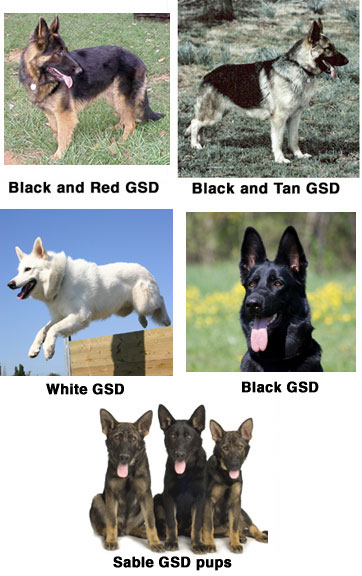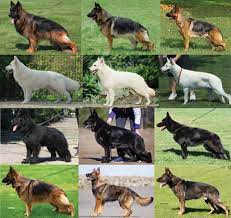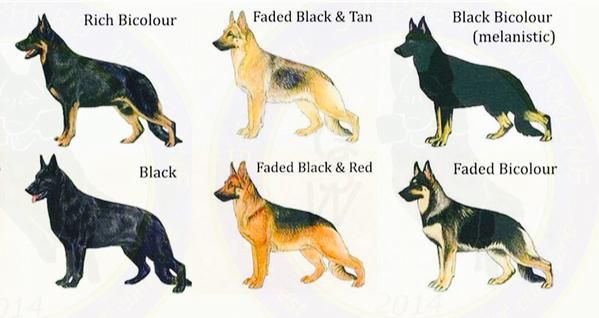Add Your Heading Text Here



What Color Are German Shepherds?
Do you believe that German Shepherd dogs come exclusively in black and tan? While black and tan German Shepherds are the most popular, particularly in the United States, there are many eye-catching German Shepherd colors.
Most of the
German Shepherd colors
feature some black face masks and some form of black body marking, ranging from a classic ‘saddle’ to an all-over ‘blanket’.
Certain German Shepherds have uncommon color variations, such as sable, black, white or blue. While the all-black and sable variations are considered acceptable by most criteria, the blue and liver varieties are considered significant flaws.
Explore the whole range of different colors of German Shepherds, before settling on a favourite.
German Shepherd Colors
Black and Tan
This is the color most people see when they think of a German Shepherd dog. Rich under a dark belly and a black face and back, this German Shepherd color has been around since the introduction of the genre in Germany in the late nineteenth century.
The black and red coat is recessive over a strong sable gene but dominates over a strong black gene.
Generally darker when birth, black and tan German Shepherds fade with maturity, with some gaining a grey strip down their backs.
German Shepherd Colors of Pure Black
While some believe that the black German Shepherd is somehow distinct from the black and tan variation, others maintain that “color has no bearing on their personalities or temperaments.”
Breeders who breed black German Shepherds may claim that their dogs are “bigger and more muscular” than other breeds of German Shepherd, however, there is no definitive data to support this claim.
Some committed owners assert that their black German Shepherds’ coats are “more luxuriant and flowing” than those of other breeds, however, there is little evidence to back this assertion as well.
The Kennel Club and the American Kennel Club recognize black German Shepherds as “recognized by all major cynology groups”.
German Shepherd Colors: White
Although many of us have seen German Shepherd white dogs, few of us can recognize them. These pale dogs, with their beautiful white coats, look like Golden Retriever with straight ears.
Often confused with the White Swiss Shepherd, or Berger Blanc Suisse, the white Shepherd is a source of controversy.
White-colored dogs are always rejected from dog shows, according to the AKC.
The United Kennel Club is one of the few organizations that acknowledge the white German Shepherd, noting that the breed “comes in a variety of hues, including white.” Even the UK Kennel Club acknowledges that “color is a secondary consideration that has no bearing on character or fitness for work.”
Despite this, in 1959, Germany began eliminating White German Shepherds from German Shepherd breeding lines because they perceived these dogs as Albinos” and claimed the white gene caused “hereditary problems and washes away the breed’s rich hues.
German Shepherd Colors: Blue
A blue German Shepherd is an uncommon yet lovely sight. A blue dog has an almost magical quality, and with amber-colored eyes, they appear even more exotic, making them extremely desirable.
Despite their popularity, the blue German Shepherd, like the white German Shepherd, has been a source of contention in the Shepherd community due to the recessive dilution gene’s association with inbreeding practices and health problems.
While it is true that their distinctive eye color and blue or “cold steel grey” coats are caused by recessive dilution genes, there is no evidence that they are more “prone to health problems” than the black and tan version.
Blue German Shepherds can resemble grey or even silver in appearance and are sometimes confused with Blue Belgian Malinois.
While some argue that “blue is an awesome color,” it does not affect the dog’s personality, and a blue German Shepherd will reflect the same exact nature of German Shepherd colors of black and red.
German Shepherd Colors Sable
A classic German Shepherd color, sable comes in a range of shades but each hair has a black tip. Sable German Shepherds come in a variety of colors, including black, grey, red, silver, and tan. They are also known as agouti.
Each hair is colored with numerous bands of brown and black, creating a wolf-like appearance. Some of the breed’s founders believed that this should be the sole color found in German Shepherds.
The sable hue of a puppy varies during its life. Black sable puppies are born all-black, whereas tri-colored sable puppies are born black and tan. As a puppy grows older, its coloration changes. Certain GSDs may require up to three years to achieve their ultimate sable color.
Because each ‘German Shepherd colors sable’ is unique in terms of color and pattern, it makes for an eye-catching and one-of-a-kind dog.
Sable is an easy-to-breed dominant color. When a Sable German Shepherd is bred to another color, sable puppies are almost always produced.
German Shepherd with a Bicolor Coat
This may appear to be a variant on the black and tan. Additionally, there is significant controversy over whether bi-color German Shepherd exhibits a pattern or a distinct color on their own.
A bi-color German Shepherd will exhibit both black and tan colors, however, black will be far more prevalent in this case. Almost the whole body will be black, with the exception of a few regions, such as the legs or chest, which will have tan to brown fur.
At birth, it might be difficult to tell a two-tone German Shepherd from its solid black siblings. If the puppy is brown under the tail, this indicates that it will grow into a bicolor dog.
German Shepherd Brown (Liver)
A remarkable feature of this German Shepherd is that the gene encoding liver fur frequently coexists with a gene encoding lovely amber eyes. By matching these two genes, biology and evolution succeeded admirably.
German Shepherds with a liver coloration can range from lighter browns to darker and warmer shades, occasionally verging on red. Additionally, the coat might incorporate hints of other colors, seamlessly merging in with the brown.
The liver comes in three primary colors: liver and tan, liver and white, and solid liver. The American Kennel Club recognizes all three of these breeds.
German Shepherd Colors: Silver
Silver, like the grey German Shepherd, has a distinguishing color. While grey and silver are sometimes lumped together, they are created by the same genes.
Finding a breeder who specializes in silver German Shepherds is significantly easier than finding one who specializes in grey German Shepherds, so this may be your best option if you’re searching for an exotic-looking companion.
Silver is rare among German Shepherd colors, presumably due to the fact that it is a recessive gene. As with the dilution gene, this gene has an effect on black pigment.
Although silver German Shepherds are recognized by the AKC, they are not frequently seen in the show ring due to the desire for more colorful, bold colors. However, silver German Shepherds are frequently seen in military and law enforcement activity.
German Shepherd Colors: Conclusion
As you can see, there are different colors of German Shepherds. While you should choose the color that appeals to you the most, avoid selecting your dog solely based on his appearance.

German Shepherds are vulnerable to developing problems with their backs and hips. Before purchasing a puppy only for his color, ensure that his breeder prioritizes health over color! Otherwise, you risk getting a puppy with stunning color but bad health, which is never a good combination.
FAQs
Do black German Shepherds change color?
Black German Shepherd puppies are born black and remain black through adulthood. So, Black German Shepherds do not change color. However, color changes are entirely dependent on the genetics and bloodline of your German Shepherd dog.
When do German Shepherds stop changing color?
If your German Shepherd dog is two years old (24 months), it is unlikely that you will notice a coat change in the future.
If you continue to notice changes in German Shepherd colors, it is worth checking with your dog breeder and your dog veterinarian.

Pingback: Der Ursprung des Deutschen Schäferhunds: Ein Leitfaden für Züchter und Hundeliebhaber